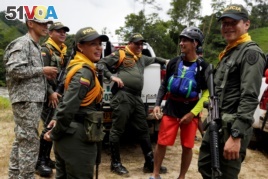18 November, 2018
Nine former members of the Revolutionary Armed Forces of Colombia, or FARC, have traded their guns for small visitor boats in Colombia's dense Amazon forest.
The former rebel fighters will now work as tour guides on the Pato River.
Former FARC member Duberney Moreno fought for 13 years. "During the conflict, this region was rough," he said, "there were bullets and bombs all the time."
"Today, so much has changed. Many people come to see the waterfalls, the mountain, the river," he said.
Almost 13,000 former fighters and their supporters are participating in a program to reenter civilian life. This reintegration program is part of a 2016 peace deal to end more than 52 years of war with the government.
The program aims to keep former FARC fighters from returning to the battlefield with smaller rebel groups like the National Liberation Army (ELN).
Many past FARC members have returned home to reunite with their families. But about 5,000 have remained in demobilization areas, like the one on the Pato, and built towns.
Fighting in Colombia has killed more than 260,000 people. Millions more have been wounded, raped and displaced.
The peace deal has progressed slowly, but the FARC is now a political party with 10 guaranteed seats in Colombia's Congress through 2026.

Duberney Moreno, ex rebel of the FARC, rafting guide and instructor, speaks with members of the police and the army in Miravalle, Colombia November 9, 2018. Picture taken November 9, 2018. REUTERS/Luisa Gonzalez
Certified rafters
The Colombian government has budgeted $1.6 million to help those in the demobilization areas. Government forces protect the areas where their former enemies farm, raise animals, make shoes and now work with visitors.
Moreno and eight other former fighters were trained to become tour guides. The International Rafting Federation provided official approval of their training.
In Caqueta province, the former fighters cook meals and drive visitors to walking paths and places to stay.
The United Nations helps run the reintegration program. Jessica Faieta is the deputy chief of the U.N.'s office in Colombia. She said, "We have to keep supporting these initiatives - they create confidence in the peace process."
President Ivan Duque, who took office in August, has said tourism could be the country's new economic driver. He said at a recent event, "I want tourism to be Colombia's new oil and for it to be the great invigorator of economic activity."
Colombia might appeal to visitors with all kinds of interests. The country borders both the Caribbean Sea and the Pacific Ocean, has Andean glaciers, wildlife, extreme sports and big cities.
More than 3.3 million people visited Colombia last year. That was more than two times the number who visited in 2010. The government estimates tourism could create 300,000 jobs and earn about $6 billion yearly.
Moreno and the other former fighters are hopeful about their future on the river.
Standing alone on the Pato, Moreno said, "We want peace. We believe a different Colombia is possible."
I'm Caty Weaver.
Reuters news agency reported this story. Hai Do adapted it for VOA Learning English. Caty Weaver was the editor.
Write to us in the Comments Section or on 51VOA.COM.
_____________________________________________________________
Words in This Story
demobilization - n. the release of someone from military service
initiative - n. a plan or program that is intended to solve a problem
confidence - n. the feeling of being certain that something will happen
invigorator - n. something that gives life and energy